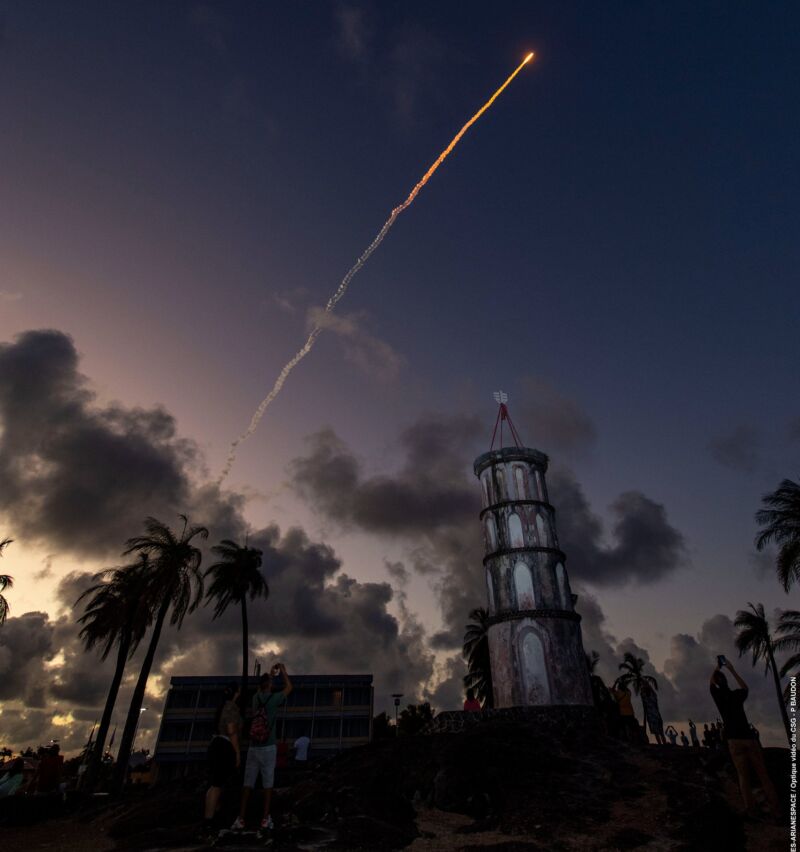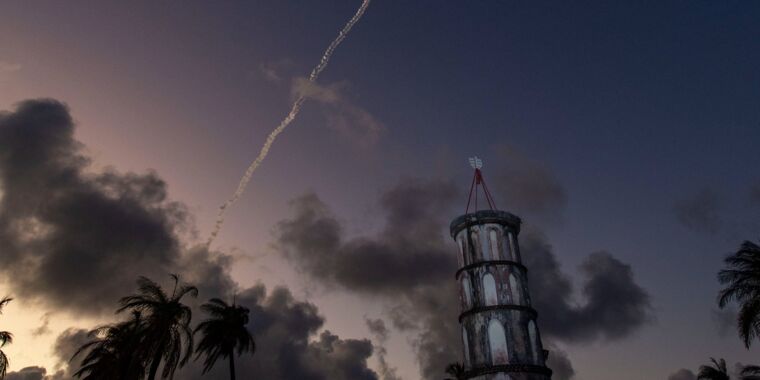
ESA
Welcome to Edition 5.10 of the Rocket Report! There is much, and more, happening in the world of lift with Firefly set to make a second launch its Alpha rocket, and NASA still attempting to make a first launch of its Space Launch System booster. Word of warning: There may not be a Rocket Report next week as I will be traveling on assignment.
As always, we welcome reader submissions, and if you don’t want to miss an issue, please subscribe using the box below (the form will not appear on AMP-enabled versions of the site). Each report will include information on small-, medium-, and heavy-lift rockets as well as a quick look ahead at the next three launches on the calendar.

Inside the long, drawn-out battle for Georgia’s spaceport. In a lengthy feature article, NBC news explores the long, seven-year battle in Georgia to develop a spaceport that would launch rockets over two barrier islands. Remarkably, with an annual budget of just $57 million, Camden County has so far spent $12 million in taxpayer money on the heretofore futile effort. “We’re paying taxes year after year after year for the spaceport, but nothing has materialized,” said Camden resident Steve Weinkle, who has become one of the most vocal opponents of the project. “This is our ‘bridge to nowhere.’”
Putting the hype in space … The story also tells the cautionary tale of spaceport promoters, who promise the world—more than the world, in fact—to communities and then often fail to deliver. The motives of outside consultants and gaps in the government’s own regulations can fuel the type of gold rush typical of any burgeoning industry, said Greg Autry, an expert on space policy. “This happens in any technology market—it’s inevitable,” Autry said. “It’s no different from the boom that you had with the Internet in the ’90s or the crypto investors a few years ago. You get a lot of people where this is not their domain and they make poor investment decisions.”
Skyroot raises $51 million. Indian space launch startup Skyroot Aerospace has raised $51 million during a Series-B funding, Spacewatch Asia Pacific reports. To date, this is the largest funding round in the Indian private space-tech sector. The company, which was founded by former engineers and scientists from the Indian space agency ISRO, said this round would help fund all of its initial development launches and build the necessary infrastructure for its rockets.
Meet the Vikram I, II, and III … The startup has recently validated three propulsion technologies for its Vikram launch vehicles, which are built with an all-carbon-fiber structure and capable of launching up to 800 kg into low Earth orbit. In addition, the company also completed a full-duration test of one of the rocket stages. Skyroot is now planning a demonstration launch later this year. (submitted by Ken the Bin)
China conducts two launches in two hours. China conducted its 36th and 37th orbital launches of 2022 within a couple of hours of each other starting late Monday, using the Jiuquan and Xichang spaceports, Space News reports. The privately developed Kuaizhou-1A solid rocket successfully lifted off into clear skies from a transport erector launcher at the Jiuquan Satellite Launch Center in the Gobi Desert at 10:24 pm Eastern, September 5. One hour and 55 minutes later, at Xichang in southwest China, a Long March 2D lifted off from Xichang, delivering three satellites into orbit.
More than two-thirds of the way there … China’s state-run rocket company is planning more than 50 launches across 2022 and recently began the launch campaign for the third and final Tiangong space station module. Chinese companies including Expace, Galactic Energy, Landspace, iSpace, and CAS Space are also conducting their own launches during the year. (submitted by Ken the Bin)

OneWeb takes a $229 million charge. OneWeb took the charge this year due to the termination of its Soyuz launch contract and dozens of satellites stranded in Kazakhstan after Russia’s invasion of Ukraine, Space News reports. The charge, the company said, is intended “to reflect the loss suffered by the Group as a result of the postponement of a planned launch on 4 March 2022, the associated postponement of subsequent scheduled launches, the loss of satellites not returned to the Group and the impairment of a portion of the Group’s prepaid launch insurance.” OneWeb was about to launch 36 of its satellites on a Soyuz from Baikonur in March when the Russian government put severe conditions on the launch, including requiring the British government to divest its stake in the company.
No dice … The board of OneWeb declined to agree to those conditions and announced it would suspend all launches from Baikonur. The satellites were placed in storage at Baikonur after the launch was called off and remain there. According to the report, the charge reflects a reduction in the value of property and equipment, such as satellites, of $272.3 million and loss of prepayments of $1 million. That is offset by the reversal of $44.1 million of charges, including payments for future launches that are no longer scheduled on Soyuz. (submitted by EllPeaTea and Ken the Bin)
Europe “cannot see” return to Russian launch. Soon after the Russian invasion of Ukraine, relations between Roscosmos and the European Space Agency broke down. Prior to the war, Europe had relied on Russia’s Soyuz rocket for its medium-lift needs—for payloads larger than its Vega rocket could accommodate but not large enough to necessitate the more expensive Ariane 5 rocket. That partnership had been expected to continue even as Europe brought a new generation of rockets, the Vega-C and Ariane 6, into service.
But no longer … “I cannot see a rebuild of the cooperation we had in the past,” ESA Director General Josef Aschbacher said in an interview with Ars. “I am speaking here on behalf of my member states. They all have very much the same opinion. And this is really something where the behavior of ESA will reflect the geopolitical situation of the member states on this point. And I think this is very clear.” ESA has since strengthened its bonds with NASA and may turn to launch services in the United States, Japan, or India.
Ariane 5 makes one of its final flights. With the successful launch of Eutelsat Konnect VHTS satellite on Wednesday, there are just three Ariane 5 rockets remaining in Arianespace’s inventory, Spaceflight Now reports. The Ariane 5, in service since 1996, is being retired in favor of the next-generation Ariane 6 rocket, a launcher European officials say will be cheaper to operate and more competitive in the global launch market.
A big bird … The Ariane 5 was once dominant in commercial launch business, but lower-cost launch services from SpaceX’s partially reusable Falcon 9 rocket have eroded Arianespace’s position. Ariane 5 rockets typically launch two large satellites at a time on missions heading toward geostationary orbit, but the Eutelsat satellite was too big to be paired with any other payload on Arianespace’s flight schedule. (submitted by EllPeaTea and Ken the Bin)
Rocket Lab joins military cargo program. The US launch company announced Wednesday that it has signed a cooperative agreement with the US military to explore the possibility of using Rocket Lab’s space launch vehicles to transport cargo around the world, Space News reports. The cooperative research and development agreement was signed with US Transportation Command, the organization that oversees global military logistics operations. The command has signed similar agreements with SpaceX and Blue Origin in support of the Air Force’s rocket cargo project to transport equipment across Earth via space.
Idea is still in the lab for now … The agreement with Rocket Lab will examine the point-to-point transportation capabilities of the company’s small launcher, Electron, and its future reusable medium-lift rocket, Neutron. It also will look at possible applications of the company’s Photon spacecraft as a platform for on-orbit cargo depots and as delivery re-entry vehicles. Rocket Lab founder and CEO Peter Beck said that point-to-point space transportation offers a “new ability to move equipment quickly around the world in hours, enabling a faster response to global emergencies and natural disasters.” (submitted by Ken the Bin and EllPeaTea)
Iridium announces 9th SpaceX launch. The satellite firm said Thursday it has reached an agreement with SpaceX to launch up to five of the company’s remaining ground spare satellites from the Iridium NEXT program on a Falcon 9 rocket. Known as Iridium-9, the launch is planned to take place at Vandenberg Space Force Base in mid-2023. Earlier this year, Iridium celebrated the 25th anniversary of the first launch in Iridium’s history, which also took place from Vandenberg on May 5, 1997. That first-ever launch carried five Iridium satellites to orbit on a Delta II rocket.
Backing up the constellation … Iridium-9 will be Iridium’s second rideshare with SpaceX. Previously, SpaceX conducted eight Iridium launches between January 2017 and January 2019. These launches delivered 75 satellites to LEO as part of the Iridium NEXT campaign, replacing the company’s original satellite constellation. Since completion of the launch campaign in 2019, Iridium has 66 operational satellites, nine on-orbit spares, and six additional spares on the ground. Up to five of those six ground spares are planned for launch as part of Iridium-9. (submitted by Ken the Bin)
A Falcon 9 landing like you’ve never seen before. The T-Zero Systems Twitter account shared video this week of a Falcon 9 first stage landing on a drone ship, as seen from a SpaceX support ship at sea. It appears as if the video was first posted on TikTok.
A boat with a view … In the video, the first stage arcs downward, holding a pretty steep angle relative to the ground before finally straightening just before touchdown. This perspective makes the Falcon 9 landing appear much more dramatic than when it is seen from the onboard camera. Worth watching.

NASA working toward September Artemis I launch. In an update with reporters on Thursday, NASA officials said that if everything goes well, they will target the dates of September 23 or 27 for their next attempt to launch the Artemis I mission on the Space Launch System rocket. The agency’s second attempt to launch the SLS rocket was scrubbed on September 3 after a hydrogen line sprang a leak where it connects to the rocket. A lot has to go right to make those dates, said NASA’s chief of exploration systems development, Jim Free. For example, NASA is working to repair the leak in a “quick-disconnect” where the hydrogen line attaches to the rocket.
Waivers sought … After this repair, the agency will attempt a fueling test no earlier than September 17, during which they will load the core stage and the upper stage with liquid hydrogen and oxygen propellants to ensure they have adequately fixed the hydrogen leak. Additionally, the agency has also submitted a waiver request to the Eastern Range, which is operated by the US Space Force. NASA needs a waiver on battery re-test requirements for the rocket’s “flight termination system,” which would be activated in case of a problem during launch. Range officials previously granted a waiver extension from 20 to 25 days, but this would extend that beyond 40 days. Should the repairs fail, or the waiver not be granted, the rocket would roll back to the Vehicle Assembly Building and launch no earlier than October 17, and possibly not until November.
The perils of liquid hydrogen. After the SLS rocket’s scrub on September 3, Ars wrote about the challenges of working with liquid hydrogen and the first stages of large rockets. Over its lifetime, due to this complexity, the similarly fueled space shuttle on average scrubbed nearly once every launch attempt. Some shuttle flights scrubbed as many as five times before finally lifting off. For launch controllers, it never really got a whole lot easier to manage the space shuttle’s complex fueling process, and hydrogen was frequently a culprit.
Keeping the workforce intact … So why did NASA continue using liquid hydrogen as a fuel for the SLS rocket if it is so difficult to work with and there are easier-to-handle alternatives such as methane or kerosene? One reason is that hydrogen is a very efficient fuel, meaning that it provides better “gas mileage” when used in rocket engines. However, the real answer is that Congress mandated that NASA continue to use space shuttle main engines as part of the SLS rocket program. This allowed traditional space contractors to continue to win lucrative awards from NASA for their work on shuttle-related hardware.
Next three launches
Sept. 11: Falcon 9 | Starlink 4-2, BlueWalker 3 | Kennedy Space Center, Fla. | 01:10 UTC
Sept. 11: Alpha | To the Black test flight | Vandenberg Space Force Base, Calif. | 21:00 UTC
Sept. 12: Falcon 9 | Starlink 4-34 | Cape Canaveral, Fla. | 02:53 UT









